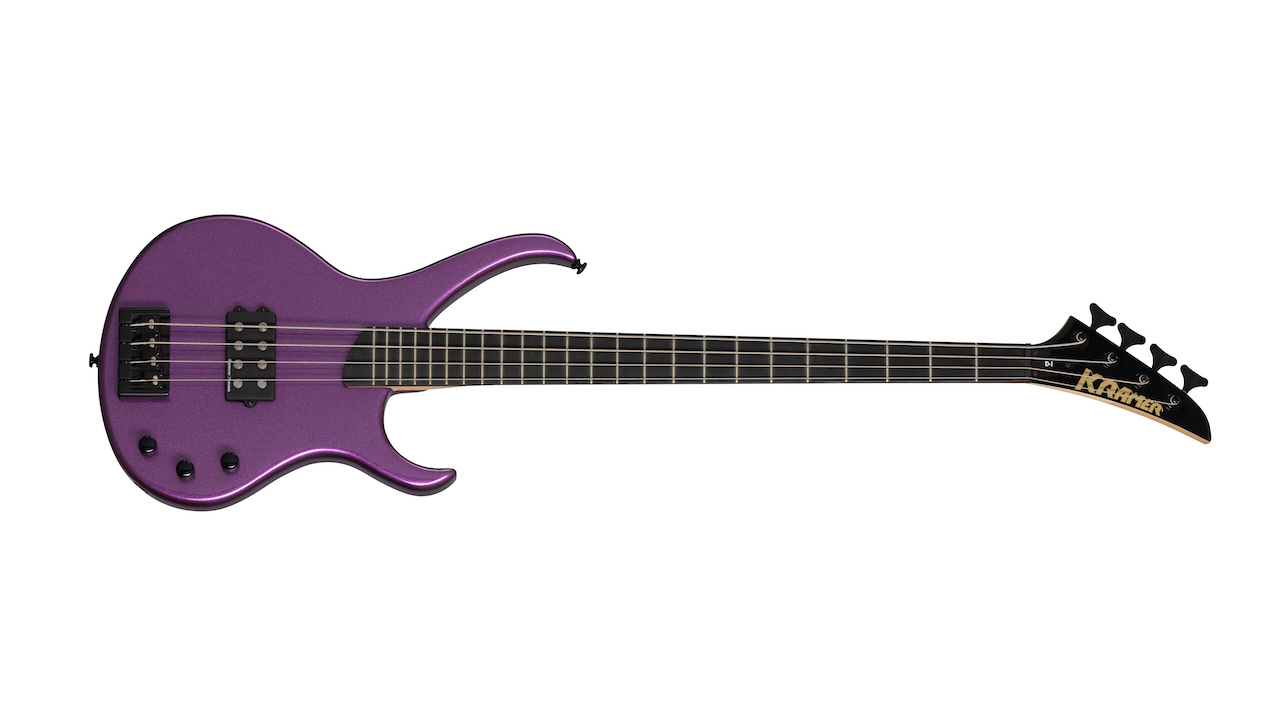Guitar World Verdict
Designed with player-friendliness in mind, the Kramer Disciple D-1 may look like a hair-metal instrument, but there’s much more to it than that.
Pros
- +
Neck is super-playable.
- +
Amazing high-register access.
- +
Ebony board is a tapper’s dream.
Cons
- -
Single humbucker offers limited tone options.
You can trust Guitar World
Steel Panther bassist Lexxi Foxx was well known for playing Kramer basses, which tells you pretty much everything you need to know about this glammed-up throwback to the Aquanet and spandex era.
Kramer and the brand’s owners Gibson have gauged this relentlessly Eighties instrument’s appeal perfectly, with choices of an amusing Thundercracker Purple finish (for the Sunset Strip crowd), or default black (for bassists who want to be taken seriously). Let’s see how this preening peacock of a bass guitar actually performs.
Build Quality

The D-1 has been designed with player-friendliness in mind, weighing in at less than nine pounds, scooping away the top of the rear with a serious chamfer profile, and allowing us easy access to the second octave with those long, curved horns. The bolt-on neck is secured with five bolts rather than the usual four, and the overall design may be very rock’n’roll but it’s also very simple.
The single humbucker and an easy-to-navigate two volumes plus master tone control layout keep things economical. Sure, the bridge and tuners are functional rather than phenomenal, but they do their job adequately enough.


Sounds and Playability
The secret weapon of this bass guitar is its Seymour Duncan SMB-4D pickup, a monster that delivers a thunderous tone even though we’re playing a passive instrument. Of course, with a single pickup unit and no coil-tap option, there are only a certain number of options for tone modulation, so don’t expect reggae-style low end or a truly glassy treble performance. Those tones aren’t what the D-1 is designed for, so look elsewhere if you need those extremes. If a more refined tone range suits your needs, though, you’ll be right at home here.



As for playability, this model is a blast to play. The rear neck finish is slick to the point of being practically frictionless, and its profile tapers off for easy access to the upper frets – enabled further by those crazy cutaways.
On our review model, the G string’s low action left it very close to the humbucker housing, but it wasn’t a problem. Another enjoyable feature of this bass is its ebony fingerboard, a hardwood that makes the D-1 a tapper’s dream. You’d better tease up your hair, put a pink scarf on and start work on that Billy Sheehan-style tapped solo.
Conclusion
Playable and very friendly to the user without being unaffordable or a pain to navigate, the Kramer Disciple D-1 may look like a hair-metal instrument, but there’s much more to it than that. A lot of thought has gone into its neck and body profiles, and while the tones are decent rather than spectacular, you probably wouldn’t buy this bass for its studio useability. Instead, enjoy its extrovert looks and give it a showcase on stage.
Specs
- PRICE: $599
- MADE IN: indonesia
- BODY: Mahogany
- NECK: Three-piece maple, 34" scale
- NECK JOIN: Bolt-on, five-bolts
- NUT WIDTH: 1.57”
- FINGERBOARD: Ebony, 24 frets
- PICKUP: Seymour Duncan SMB-4D
- CONTROLS: 2 x Volume, Master Tone
- HARDWARE: Kramer tuners and bridge
- WEIGHT: 8.8 lbs / 3.9 kg
- GIGBAG/CASE INCLUDED? No
- LEFT-HAND AVAILABLE? No
- CONTACT: Kramer Guitars
All the latest guitar news, interviews, lessons, reviews, deals and more, direct to your inbox!
Joel McIver was the Editor of Bass Player magazine from 2018 to 2022, having spent six years before that editing Bass Guitar magazine. A journalist with 25 years' experience in the music field, he's also the author of 35 books, a couple of bestsellers among them. He regularly appears on podcasts, radio and TV.


